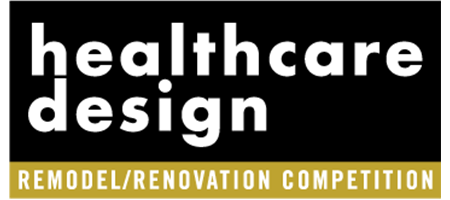A technology solution that combines interactive positive distractions and room controls to support de-escalation in behavioral health settings. A reusable fabric privacy curtain that reduces the strain and time required for staff to change out curtains. And a manual-operated window shade that eliminates cords, improving both safety and maintenance.
These are some of the product innovations that rose to the top in the 2024 Nightingale Awards product design competition at the Healthcare Design Conference + Expo, held last October in Indianapolis.
This annual program recognizes product design and innovations that support healing and productivity. As part of the judging process, a jury of healthcare architects, interior designers, and facility executives visits with exhibitors prior to the expo hall opening to examine the products, hear about specific features from participating companies, and ask questions of the manufacturers as they consider how the entries meet the awards program criteria.
The judges then determine gold and silver winners in specific product categories, from architectural products to flooring and furniture, as well as recognize those for sustainability and innovation advancements. In 2024, 34 products received awards across 16 categories.
While the experience gives jurors a front-row seat to observe new products and design features for healthcare environments, it also provides an opportunity for them to gauge the overall market.
Nightingale juror roundtable discussion
To hear their insights, Healthcare Design invited Nightingale jurors to a roundtable discussion where they shared what stood out to them at the HCD Conference as well as what product needs and challenges are still on their radars.
In December 2024, Editor-in-Chief Anne DiNardo moderated a discussion via Zoom with Kathleen Benoit, associate principal, project manager, Architects Alaska (Wasilla, Alaska); Lauren Cole, senior director, planning and design, Providence Health (Portland, Ore.); Angela Crum, associate partner, director, healthcare practice, Kirksey Architecture (North Texas); Julie Dumser, RN, principal, Branches Health Consulting (Indianapolis); Christina Early, project manager-construction, Hamilton Healthcare System (Dalton, Ga.); Heather Flannery, principal, Hord Coplan Macht (Baltimore); Pam Houston, architect, healthcare planner, CPL Architecture Engineering Planning (Raleigh, N.C.); Margi Kaminski, principal, health interiors practice leader, CannonDesign (Chicago); and Jennifer Kenson, principal, FCA (Philadelphia).
Read on to hear what they shared.
Winners delivered solutions to address operational, clinical challenges

Lauren Cole (Headshot credit: Courtesy of Lauren Cole)
While continued advancements to products for healthcare environments, including improved aesthetics and expanded color and textile options, made an impression on jurors, the products that really stood out demonstrated a clear understanding of facilities’ operational and clinical challenges and provided solutions to address them.
“The entries that we were excited about were actively solving problems that our teams, whether its design or facilities, are up against every day,” says Cole of Providence Health.
One of those winning products was Standard Textile’s AMY Privacy Curtain, a reusable, all-fabric curtain with a Y-Hook tab design, says Cole. The design replaces plastic, metal, hooks, grommets, or snaps, supporting rapid change-outs and laundering, which helps address staffing shortages and room turnover. “It’s genius,” Cole says. “It might seem like a small detail, but it solves a lot of operational problems for us.”
Other jurors agreed, awarding the curtain system a Gold Award in the Architectural Products: Non-Clinical category and the Best of Sustainability Award.

Christina Early (Headshot credit: Hamilton Healthcare System)
“I think [the company has] done its homework,” says Hamilton Healthcare System’s Early. “They’ve listened. I think more manufacturers can have those same advantages. If they take a minute and go back to the root cause [of an issue], they can come up with some great solutions.”
Read the Nightingale Awards Best of Sustainability Q+A here.
In addition to solutions-oriented products, the jurors say they were also impressed with entries that are backed by research or data about their effectiveness in real-world environments—especially as internal design teams at facilities continue to run lean.
“Having someone help us with the burden of post-occupancy evaluation would be incredibly helpful,” says Cole. “We all understand the value of it, but we don’t have the time or the resources to devote to it.”
During Recornect’s presentation of its CoWin Digital Media Wall, a technology solution featuring a customizable interface with applications, games, and room controls to support de-escalation in behavioral health settings, company representatives shared research with Nightingale jurors showing that the product resulted in a 60 percent reduction in the use of restraints.

Pam Houston (Headshot credit: Richard Barlow Photography, Inc.)
Those findings—along with the product’s all-in-one-solution for behavioral health environments—helped earn CoWin the Best of Competition Award. The technology product also can be customized to support different patient needs, providing a flexible solution that can appeal to a variety of age ranges.
“Having a screen in a patient room is nothing new, nor is the surround for protection and ligature resistance,” CPL’s Houston says. “It was more the way it’s being programmed and the way it’s being utilized in the room—that interactive component is a huge part of it.”
The panelists say they also appreciated product features that are more accessible to a broad range of users of different ages and abilities.
For example, the solar shades with Newton High-Speed Lite Lift technology by Standard Textile and Altex feature a loop at the end of the wand that can be pulled to raise and lower the shade.

Margi Kaminski (Headshot credit: Courtesy of CannonDesign)
“For an older adult, it’s very difficult to twist the wand if you have an arthritic hand,” says CannonDesign’s Kaminski. “But that loop design makes it more accessible.”
Read the Nightingale Awards Best of Competition Q+A here.
Healthcare product market demands innovation
Behavioral health products have been on Nightingale judges’ radar for several years as growing demand for services and facility improvements continue to drive the market for new products.
Looking at this year’s entrants in the category, Benoit says she was encouraged to see that products are “becoming much more aesthetically pleasing.”

Kathleen Benoit (Headshot credit: Courtesy of Architects Alaska)
For example, she notes, Pineapple Contracts’ Arc bathroom line, which took home a Gold Award in the Behavioral Health Bathroom Fittings & Furnishings category, looks like a piece of furniture but is seamless and safe for patients and their caregivers.
She also appreciated Visa Lighting’s Liberty Switches for having clean lines.
“It’s simple yet rated for high-abuse areas,” Benoit says. “I would specify it in any environment.”
The product was recognized with a Nightingale Innovation Award.
Read the Nightingale Awards Best of Innovation Q+A here.
Along with these improvements, several jurors noted that there could be an opportunity for some behavioral health furniture to be considered for other acute care environments, to meet a facility’s need for durable and cleanable furnishings that support a range of patients.

Jennifer Kenson (Headshot credit: Alyssa Maloof)
“I think there are spaces in medical units where this type of furniture could be utilized, like family lounges,” Kenson of FCA says.
Branches Health Consulting’s Dumser agrees, adding that she’s seeing more product features such as secure clean outs, fabrics, and color options that could make them more flexible for use in acute care settings and “not just pegged as behavioral health.”
Flannery says expanding those product lines so they’re safe and appropriate for different uses and departments could help blur the lines between different care settings to support a holistic facility design.

Julie Dumser (Headshot credit: Captures by Chrissy Malott)
“You get this cohesive look across an entire system without thinking, ‘I know I just stepped into behavioral health, and now I know I’m in the labor and delivery department,’” she says. “It’s nicer with those blurred lines, so everyone feels that they’re being treated the same.”
However, Cole notes that some behavioral health products come at a premium, which may limit their application on some projects. “We don’t always have the budget to support distributing it across the facility as much as we would like.”
CannonDesign’s Kaminski adds that while manufacturers have listened to the industry’s needs for safe, durable, and aesthetically pleasing products for behavioral health environments, many options use plastic materials to meet these needs. As the industry continues to make strides, she says she’d like to see other alternatives.
“The pandemic accelerated interest in behavioral health, so now the monies are there and therefore the research and development are definitely accelerated, and I think it shows,” she says.
Future demands and healthcare product opportunities
Looking to future needs for healthcare environments, Early says she sees an opportunity for more products and services to support renovations, such as furniture, transitional flooring solutions, and accessories that complement or enhance the existing built environment.
“We’re trying to find things that actually mirror up and functionally work in a space where I may keep the casework, but I might change the laminate to a solid surface or the flooring may change,” she says. “When you’re in an old environment and trying to renovate and update it to the new standards or branding, it’s a challenge.”
Kenson says she’d like to see more medical equipment “catch up to the furniture industry,” such as non-plastic options for waste bins and soiled materials containers that better complement patient room designs, as well as more aesthetically pleasing storage options for personal protective equipment that are “nice without having to do a custom built-in.”

Angela Crum (Headshot credit: Courtesy of Kirksey Architecture )
As healthcare clients continue to face financial pressures amid rising acuity care needs and an ever-changing market, Kirksey Architecture’s Crum says she is seeing more scrutiny over project budgets and price points, driving demand for more affordable products.
“My most recent clients are looking for lounge guest chairs that meet the quality that healthcare environments demand under $400,” she says. “They’re looking for very tight price points that I’ve never had to accommodate before.”
Anne DiNardo is editor-in-chief of Healthcare Design. She can be reached at [email protected].











